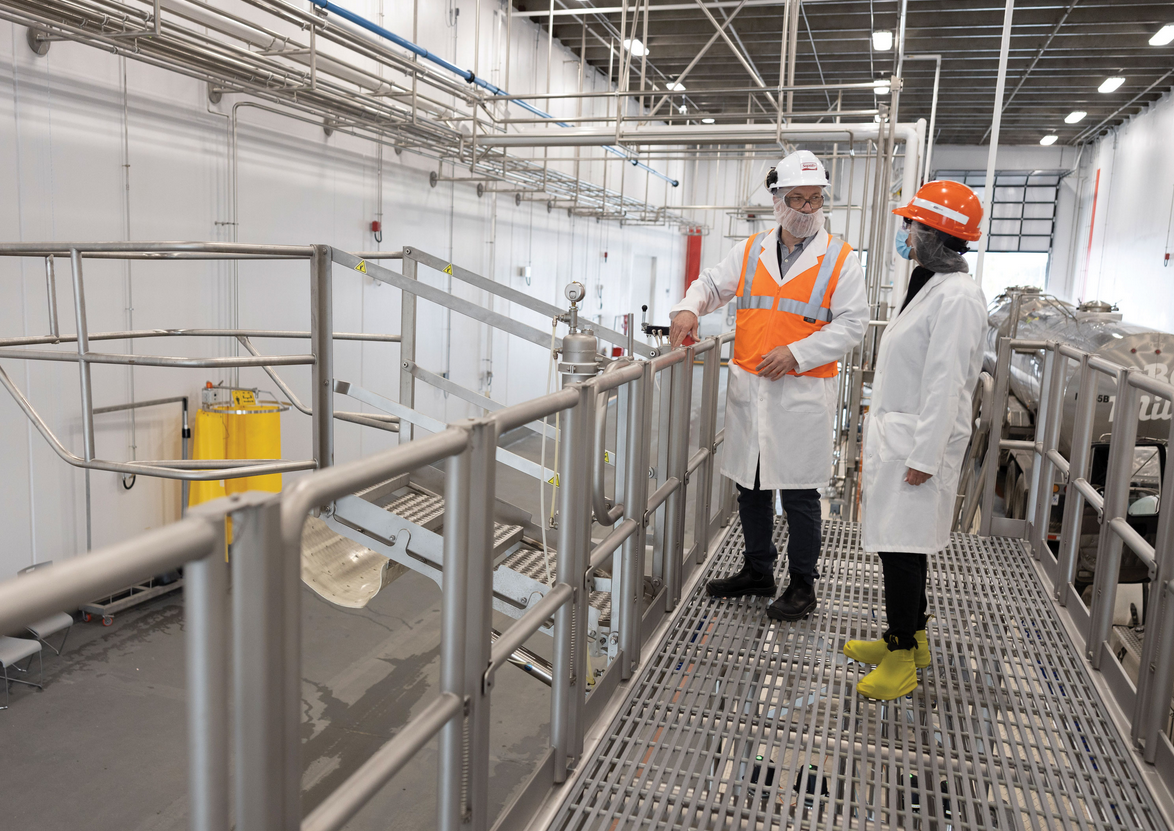Workplace design has a positive impact on workers
At Saputo’s milk and cheese production plants in Port Coquitlam and Abbotsford, design is everything — ergonomic design, that is.
By Marnie Douglas
In 2010, the dairy processor was seeing an increased level of musculoskeletal injury (MSI) claims. The employer had identified that their MSIs were coming from the cheese production area, and they were committed to finding a solution. They consulted with WorkSafeBC to find solutions aimed at preventing these workplace injuries.
MSIs make up about one third of all claims WorkSafeBC sees in a year. These injuries affect the soft tissues of the body, such as muscles, tendons, joints, and nerves.
Identifying the challenges
“Preventing these injuries requires taking a close look at work tasks and equipment, and making the necessary workplace changes,” says Gina Vahlas, an occupational hygiene officer (OHO) with WorkSafeBC. Before moving to her OHO role, Vahlas was an ergonomist, assisting prevention officers and employers in designing their workplaces to prevent MSIs and other injuries. “We start by using a participatory approach, talking to workers and supervisors to get an understanding of how they perform their work tasks and what the challenges may be, before moving to developing solutions.”
Vahlas visited Saputo’s Abbotsford plant and interviewed workers, analyzing how staff interacted with equipment, their workspaces, and observing work on the production floor looking for MSI risk factors. This process helped her to better understand the challenges workers were facing and gather their ideas for possible controls.
Her report, presented to the now-retired plant manager, Raynald Leclerc, and the joint health and safety committee, provided a starting point to educate the group about MSI risk factors and ergonomics. With the commitment of Leclerc, and the collaboration of the safety team and staff, a participatory ergonomics process was introduced.
This process included consulting with employees who shared, first-hand, their challenges and ideas about what might help them with their work. Vahlas then was able to facilitate a brainstorming session with the team to develop solutions to prevent MSIs and other types of injuries.
As part of this, and with Vahlas’ help, Saputo’s team decided on and implemented engineering design controls. “Ideally, solutions are mocked up and tested before they are implemented to make any necessary adjustments,” she noted. “It doesn’t have to be an expensive prototype; I have used something as simple as cardboard to mock up a proposed solution.”
At the Abbotsford plant, those changes included reconfiguring equipment to fit the worker — a process that involved “making physical workplace changes to reduce risk factors and prevent injuries,” says Vahlas.
Prevention by design
“The plant manager committed to using a consultative approach with their workers to implement controls,” she explains. “In follow-up visits, I observed the changes to engineering controls, such as lowering tracks to reduce over shoulder height work, using vacuum lifts to reduce force, making stacks of materials smaller, and using a height adjustable pallet jack to be able to adjust lifting heights between hip and shoulder height.”
Vahlas shared that an ergonomic approach will help prevent MSIs and other injuries but it goes beyond that; it also helps create process efficiencies and improve workplace health and safety culture.
Tony Di Cicco, Saputo’s regional health and safety specialist, says employees noticed the improvements in their discomfort immediately, as well as improvements in communication and morale, particularly for those who had been with the company for many years.
“It was a bit of a surprise to all of us, to be honest. We didn’t realize how much ergonomics could play a role in employee health and safety, and it really made us look closer at ergonomics overall,” he says.
Saputo took what it had learned through the implementation of ergonomic design at the Abbotsford plant and incorporated it when constructing its state-of-the-art milk and dairy alternative beverage facility in Port Coquitlam. Says Di Cicco: “When we had the opportunity to build a new facility, we kept ergonomic design top of mind.”
For example, at the new Port Coquitlam facility, which opened in August 2021, valves and maintenance controls were made accessible from the floor as opposed to using ladders. Also, the offloading milk station above trucks was constructed with guardrails instead of relying on personal fall protection equipment. These design considerations improve work processes and create efficiencies while helping to reduce injuries and prevent incidents, like falls.
“Employees are definitely noticing a difference; they’re not having to lift or strain to complete tasks,” adds Colleen Nechvolodoff, Saputo’s environmental health and safety coordinator. “There’s also been significant positive feedback.”
In addition, Saputo has a physiotherapist on-site two days per week to further support the health and safety culture for the plant’s employees.
Long-term benefits
The improvements are paying off for Saputo — overall, MSI claims dropped significantly between 2010–2019, but more importantly staff feel like their health and safety matters, especially when they see their feedback leading to positive changes.
Vahlas hopes that Saputo’s success can help other businesses learn from the company’s commitment to the participatory ergonomics process, and inspire design improvements as a means to sustainable health and safety.
“The best time to incorporate ergonomics is at the start: when you are designing, planning, and procuring your workplace facilities, workstations, equipment, and setting up processes and workflow,” remarks Vahlas. “People come in different shapes and sizes and perceive their surroundings differently. All of this needs to be considered in the design — ultimately it will lead to better health and safety performance.”
For more information on workplace ergonomics visit worksafebc.com/ergonomics.
This information originally appeared in the May/June 2022 issue of WorkSafe Magazine. To read more or to subscribe, visit WorkSafe Magazine.

